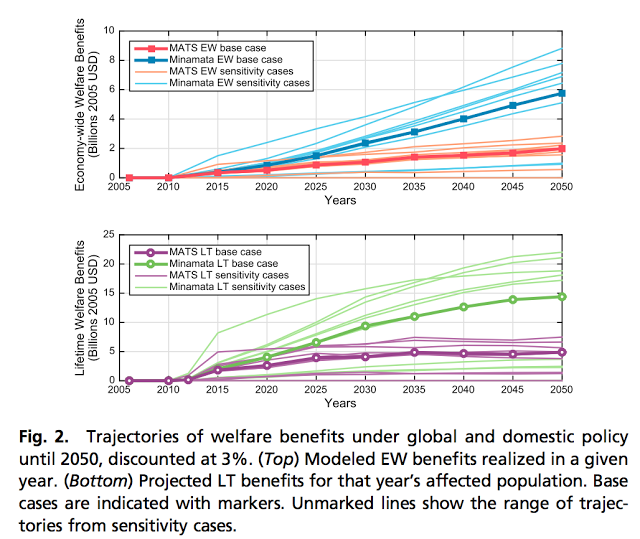Mercury pollution is a global problem with local consequences: Emissions from coal-fired power plants and other sources travel around the world through the atmosphere, eventually settling in oceans and waterways, where the pollutant gradually accumulates in fish. Consumption of mercury-contaminated seafood leads to increased risk for cardiovascular disease and cognitive impairments.
In the past several years, a global treaty and a domestic policy have been put in place to curb mercury emissions. But how will such policies directly benefit the U.S.?
In a new study published this week in the Proceedings of the National Academy of Sciences, MIT researchers report that global action on reducing mercury emissions will lead to twice the economic benefits for the U.S., compared with domestic action, by 2050. However, those in the U.S. who consume locally caught freshwater fish, rather than seafood from the global market, will benefit more from domestic rather than international mercury regulations.
The researchers calculated the projected U.S. economic benefits from the Minamata Convention on Mercury, a global treaty adopted in 2013 to reduce mercury emissions worldwide, compared with the Mercury and Air Toxics Standards (MATS), a national regulation set by the U.S. Environmental Protection Agency to reduce mercury pollution from the country’s coal-fired power plants.
Overall, while both policies are projected to lead to roughly the same amount of reductions in mercury deposited on U.S. soil compared to a no-policy case, Americans’ consumption of mercury by 2050 are estimated to be 91 percent lower under the global treaty, compared to 32 percent under U.S. policy alone. The researchers say these numbers reflect the U.S. commercial fish market, 90 percent of which is sourced from Pacific and Atlantic Ocean basins — regions that are heavily influenced by emissions from non-U.S. sources, including China.
From their projections of reduced mercury consumption, the researchers estimated health impacts to the U.S. population under both policies, then translated these impacts into economic benefits. They characterized these in two ways:
1. projected lifetime benefits from an individual’s reduced exposure to mercury, including willingness to pay for lowering the risk of a fatal heart attack, cost savings from avoided medical care, and increased earnings; and
2. economy-wide benefits, or the associated productivity gains of a national labor force with improved IQ and fewer heart attacks, as a result of reduced exposure to mercury.
Based on these calculations, the team estimated that by 2050, emissions reductions under the Minamata Convention on Mercury would lead to $339 billion in lifetime benefits and $104 billion in economy-wide benefits in the U.S., compared to $147 billion and $43 billion, respectively, from MATS. The global treaty, then, should lead to more than twice the benefits projected from the domestic policy.
PNAS – Benefits of mercury controls for the United States
Significance
Mercury is a globally transported pollutant with potent neurotoxic effects for both humans and wildlife. This study introduces an assessment method to estimate the potential human health-related economic benefits of global and domestic mercury control policies. It finds that for the US population as a whole, global mercury controls could lead to approximately twice the benefits of domestic action by 2050. This result is robust to several uncertainties and variabilities along the emissions-to-impacts path, although we find that those consuming locally caught freshwater fish in the United States could benefit more from domestic action.
Abstract
Mercury pollution poses risks for both human and ecosystem health. As a consequence, controlling mercury pollution has become a policy goal on both global and national scales. We developed an assessment method linking global-scale atmospheric chemical transport modeling to regional-scale economic modeling to consistently evaluate the potential benefits to the United States of global (UN Minamata Convention on Mercury) and domestic [Mercury and Air Toxics Standards (MATS)] policies, framed as economic gains from avoiding mercury-related adverse health endpoints. This method attempts to trace the policies-to-impacts path while taking into account uncertainties and knowledge gaps with policy-appropriate bounding assumptions. We project that cumulative lifetime benefits from the Minamata Convention for individuals affected by 2050 are $339 billion (2005 USD), with a range from $1.4 billion to $575 billion in our sensitivity scenarios. Cumulative economy-wide benefits to the United States, realized by 2050, are $104 billion, with a range from $6 million to $171 billion.
Projected Minamata benefits are more than twice those projected from the domestic policy. This relative benefit is robust to several uncertainties and variabilities, with the ratio of benefits (Minamata/MATS) ranging from ≈1.4 to 3. However, we find that for those consuming locally caught freshwater fish from the United States, rather than marine and estuarine fish from the global market, benefits are larger from US than global action, suggesting domestic policies are important for protecting these populations. Per megagram of prevented emissions, our domestic policy scenario results in US benefits about an order of magnitude higher than from our global scenario, further highlighting the importance of domestic action.

Brian Wang is a Futurist Thought Leader and a popular Science blogger with 1 million readers per month. His blog Nextbigfuture.com is ranked #1 Science News Blog. It covers many disruptive technology and trends including Space, Robotics, Artificial Intelligence, Medicine, Anti-aging Biotechnology, and Nanotechnology.
Known for identifying cutting edge technologies, he is currently a Co-Founder of a startup and fundraiser for high potential early-stage companies. He is the Head of Research for Allocations for deep technology investments and an Angel Investor at Space Angels.
A frequent speaker at corporations, he has been a TEDx speaker, a Singularity University speaker and guest at numerous interviews for radio and podcasts. He is open to public speaking and advising engagements.



